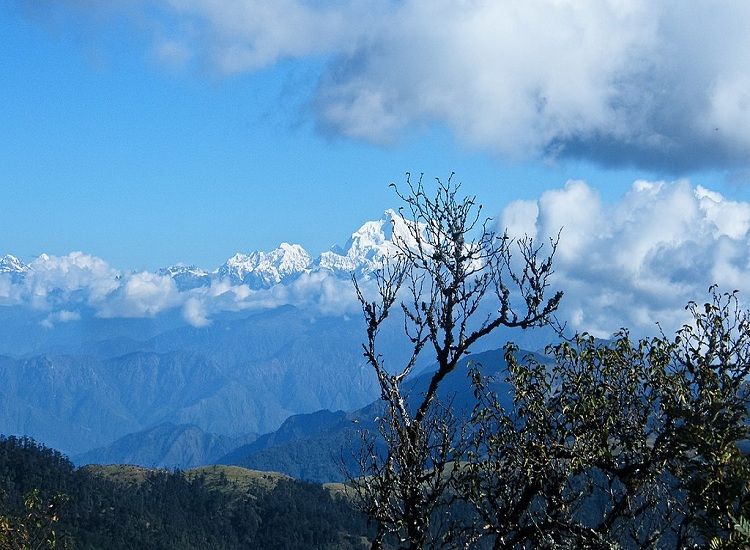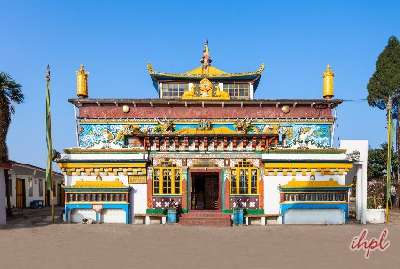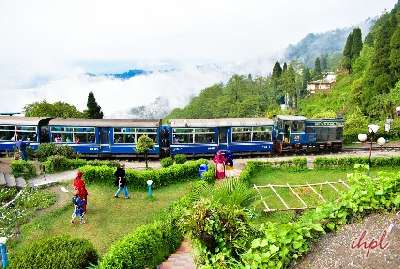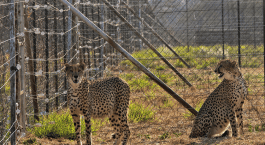Inscribed as a UNESCO World Heritage Site, the Khangchendzonga Biosphere Reserve (KBR) is a high-altitude national park that carefully preserves exotic wildlife and species of flora and avifauna. A paradise for trekkers and hikers, the park is a starting point for several breathtaking trekking trails. Passing through mysterious forests and terrains, these trails offer matchless experiences to the navigators by taking them up and astounding them with awe-inspiring views of Mount Khangchendzonga.

Unlike other national parks, the Khangchendzonga National Park (KNP) is rather special due to its distinctive features. One of the key characteristics is that the park represents a protected area within the KBR. Besides providing glimpses of stunning biodiversity like endangered red and rare orchids, the park also gains attention by displaying how humans and animals exist in harmony in the park.
The fusion of culture, religion, and environmental protection is tangible proof of the respect towards Mt. Khangchendzonga, a guardian deity, by the people of the indigenous communities.
Since the peaks, rocks, and lakes are revered, the community has adopted the landscape as their cultural identity. Also, their traditional knowledge has helped them to influence and shape conservation so much. One instance of the same is when people stood against two hydropower projects on the ‘sacred river’ Rathong Chu on religious and environmental grounds. The opposition was so strong that both of the projects were scrapped.
Spanning over 1784 km, KBP is a high-altitude park that enjoys both cultural and ecological importance. UNESCO recognized the park as a Mixed World Heritage Site for its intangible as well as tangible heritage. It is interesting to note that it is the first one in India to be recognized both for its natural and cultural importance.
As of now, the Khangchendzonga Biosphere Reserve has been entitled under UNESCO’s World Network of Biosphere Reserves (WNBR), of the Man and the Biosphere Programme (MAB). This has become the reason for much jubilation in the state of Sikkim. Interestingly, the state is already cherished for organic farming policies, ecotourism, and conservation.
The development has been welcomed by locals, scientists, and conservationists. They believe that the new recognition will aid in providing an effective measure to bridge the gaps in conservation, livelihood challenges, and development. This includes reducing pressure on the natural resources in transition zones and restricting the maximum number of tourists allowed to the core area.
According to the director and member secretary of the Indian National MAB Committee of the Ministry of Environment, Forest and Climate Change, Tashi Wangdi, the achievement opens up the possibility of involving and teaming up with biosphere reserves in the MAB network internationally. This will help to view development and conservation in a holistic manner.
Zones in the Khangchendzonga Biosphere Reserve
Wangdi informed Mongabay-India that they have buffer, core, and transition zones in the biosphere reserve. The KBR consists of the KNP as its core area. Falling under the Wildlife Protection Act, it is a legal identity. He also told that the major challenge lies in the transition and buffer zone which spread hundreds of kilometers beyond the core area.
According to UNESCO, the buffer zone lies adjacent to the core zone, and activities associated with sound ecological practices that can reinforce monitoring, scientific research, education, and training are conducted here.
The greatest activity is allowed in the transition area. This supports human and economic development that is ecologically and socio-culturally sustainable.
The park is surrounded by areas that are essential parts of the villages inhabited by nearly 35,000 people belonging to the Bhutia, Lepcha, Limboo, and Nepalese communities.
Expressing his concerns, Wangdi said that they have to chalk out various measures to reduce the pressure on the natural resource and forests. Also, how the socio-economic status of the people residing in the nearby areas can be improved? The natives depend on natural resources and forests for their livelihood. Thus, one of the challenges is to create options for livelihood so as to ease the pressure on natural resources.
Besides this, the World Network of Biosphere Reserves enhances the possibility of better involvement of the concerned ministry departments for problem-solving and raising resources and funds for conservation work.
Wangdi further said that apart from this, they pay attention to the development and research activities so as to analyze the gap areas in development, conservation, and livelihood. This effort is made so as to address them efficiently.
Hemant K. Badola, advisor (biodiversity) in the office of Sikkim’s Chief Minister Pawan Chamling told that the state is paying much attention to the importance of the culture dissemination among the masses and the conservation of the landscape. He, in an interview with the Mongbay-India, made a statement that it is a tough task to monitor and regulate soaring tourism over the ecologically sensitive Himalayan zones and fragile terrains. The tourists are enchanted by the organic landscape of Sikkim. A clear manifestation of the necessary measures demanding strong participation by the community is depicted by the Sikkim policies.
A prominent author of the UNESCO MAB nomination document of KBR, Badola, highlighted that the new entitlement implies that the Sikkim government policies related to the promotion of organic farming, ecotourism, and socio-economic development in the transition zone of KBR have turned out to be ‘highly beneficial’.
As per a statement made by Badola, former scientist-in-charge of the G.B. Pant National Institute of Himalayan Environment & Sustainable Development (Sikkim), it is also important to understand that organic farming in the KBS’s transition zone holds great relevance to the enrichment of the biodiversity in the area.
Badola further added that umpteen scientific studies worldwide suggest that the organic management in cropping enhances biodiversity and boosts the richness of the species. There have been pieces of evidence, over the years, which have proved that the organic farming in the KBR’s transition zone yielded better soil fertility, increased water absorption, and bountiful pollinators, due to which there was an enhancement of the biodiversity elements, both faunal and floral.
New ways of understanding
The Khangchendzonga Biosphere Reserve occupies nearly 40 percent of the state and is reckoned as one of the world’s largest ecosystems. Encompassing an area of 2931 sq. km, the landscape elevates from 1,220m to 8586m.
Nestled in the Himalayas global biodiversity hotspot, KNP’s complex has ancient and rugged terrains which are covered with forests. These terrains are a haven for wildlife enthusiasts, bird watchers, rock climbers, star-gazers, and pilgrims.
Yuksom, the first capital of Sikkim and a serene hamlet nearby the entry point of KNP beguiles the tourists with an unhurried lifestyle, friendliness, inviting and warm homestays, and much more. Traditional food is an added plus. All these not only offer a complete rustic experience and ensure sustainable livelihood but also enable the natives to manage and protect the forest as per the state’s eco-tourism policy.
Enrolled with the Sikkim government, Khangchendzonga Conservation Committee (KCC) is regarded as a pioneer in ecotourism in India. The Yuksom-based NGO supports the natives to run and manage homestays. The NGO also keeps an eye on the impacts of these homestays.
The arrival of the trekkers and the waste and items brought by them into the park has been diligently monitored by the KCC.
Every item brought back is thoroughly checked against those listed at the time of entry, upon their exit from the park. If any item is found missing, a fine is imposed on them, as a missing item indicates littering within the protected area. In the same way, the unauthorized removal of medical plants and specimens including moths and butterflies is strictly prohibited.
When the opinions of the locals were asked, they suggested the need for extra monitoring staff and patrolling. Even the KNP management plan indicates the need for trained staff to safeguard some medicinal plants in the park from unauthorized extraction. It also discusses regular patrolling to monitor cattle grazing inside the park.
Need to analyze the carrying capacity of the park
Pema G. Bhutia, a member of the organization recently revealed that the major cause of concern is the travel companies bringing in lots of tourists at a go. He stressed the importance of analyzing the park’s carrying capacity.
In an interview given to Mongabay-India Bhutia told that one factor they are considering is that some travel companies exploit the national park. We have some companies who bring 40-50 people simultaneously and promote mass tourism. With KNP holding the UNESCO tag, they hoped that there will be regulations and studies in place regarding the park’s carrying capacity. They also wish that with renewed attention, some measures will be taken.
B.S. Siktel, the director of KBR also agrees to it. According to him, bio-piracy has been reduced and poaching is no more a challenge but tourism has accelerated. No studies have been carried out so far regarding the carrying capacity of the park and we are also not aware of the same. He also added that the site is a paradise for pilgrims and trekkers and ecotourism is a major moneymaker for the aboriginal communities. While they understand the importance of tourism, they are also aware of the pressure caused due to mass tourism.
Pointing to the park’s management plan (2008-2018), Siktel highlighted the threats of unregulated tourism including harm to vegetation and a shift in the behavioral patterns of the wild animals in general.
Un-designated camping sites, uncontrolled dumping of garbage, and use of local timber wood for cooking pose a serious challenge to the bio-resources of the park.
KCC provided the data which pointed out that KNP received 289 international groups and 457 tour groups in 2012. There was a steep decline in the count in 2015 i.e., 181 international groups and 150 Indian groups marked their presence in the park. 2016 saw an acceleration in tourist arrival as there was an uptick to 186 international groups and 261 Indian groups.
Also Read:
Another side of the coin
While the number is only one side, there is another side of the coin as well.
One of the main principles of ecotourism followed at the Yuksom is a conversation between guests and hosts. As per Uden from KCC, this conversation (a casual interaction on a jungle trek over a bonfire) is done to make visitors aware of the culture and landscape. More awareness of the visitors means fewer chances of inadvertent harm to the place.
But, several fly-by-night operators and private hoteliers ignore the awareness part of the deal.
Uden said that due to this guests lack the proper information to value the landscape. Also, the community remains deprived of the benefits of ecotourism. He further said that their model of ecotourism depends on travelers viewing the landscape with respect and this move prompts positive actions such as not littering on the trek. This aids in conservation.
To strengthen the point of awareness, Bhutia mentions the example of the Darjeeling Himalayan Railway, a UNESCO World Heritage Site, fondly known as the toy train.
Bhutia cited that the matchless experience of joy and pride that one revels in while riding the Darjeeling Himalayan Railway should be felt by the tourists visiting the KBR/KNP landscape as well. He stressed that rather than thinking that they are exploring one of the national parks of India, visitors should understand the difference that KNP is special. He also felt the need to work hard and create awareness in this regard.
The management plan cites the changing character of traditional villages, reduced use of Bhutia, Lepcha, and Nepali languages, and concerns about the cultural appropriateness of ‘nightlife’ of the tourist-town, as some of the worries regarding the impacts of tourism.
According to the plan, there is an apparent loss of Bhutia, Lepcha, and Nepali identity in their own homeland at the heart of all these concerns. There is also a wish to preserve tourism styles that are apt to the cultural context and the national park.
Combining conservation with traditional knowledge
The Khangchendzonga Biosphere Reserve consisting of the Khangchendzonga National Park forms the Khangchendzonga landscape which lies between India, Bhutan, and Nepal.
Badola highlighted the significance of linking human-centric biodiversity conservation to the transboundary nature of the Khangchendzonga landscape.
Badola, the former scientist for the Khangchendzonga Landscape, India part, explained that the stoicism of the park is proof of the fact that knowledge of the bio-culture from natives can result in biodiversity conservation benefits and protection of a region.
Knowledge of bio-culture signifies the interconnectivity between biodiversity and human behavior.
Being a resident of Sikkim for over twenty years, C.S. Rao, the chief wildlife warden of the state, agrees with the fact that despite the occurrences of crop destruction by animals in the area, the retaliatory killings are overlooked because of the veneration of Mount Khangchendzonga.
Badola cited the harnessing of medicinal plants as an example of the continuation and preservation of biocultural knowledge. For example, 124 plants are used by the Limbu tribes for curing 77 ailments whereas 118 medicinal plants are used by the Lepcha tribe for curing 66 ailments.
He added that this knowledge is the secret to how communities have adapted and responded to several changes in the environment with respect to globalization and climate change.

 Tranquil Sikkim & Darjeeling Tour
Tranquil Sikkim & Darjeeling Tour Sikkim Darjeeling Tour
Sikkim Darjeeling Tour Darjeeling Gangtok Pelling Tour
Darjeeling Gangtok Pelling Tour North East with Dooars
North East with Dooars


Leave a Comment